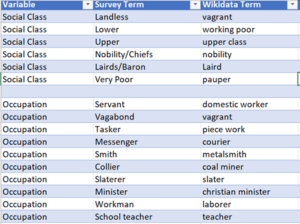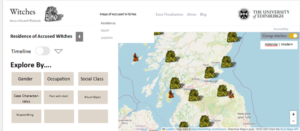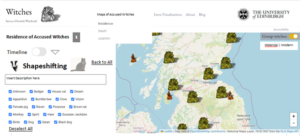I am now coming the end of my third week as the Witchfinder General – Data Visualisation intern and time has flown by. Over the past 2 weeks I have begun on the journey of Quality Assuring the data and improving the website.
This process began by dealing with the anomalies between the names and gender of accused witches that the previous intern, Claire had found and then after consulting with Professor Julian Goodare about these differences making the corresponding necessary changes in wikidata. Then I began with looking at different properties, starting with social class and occupation. From this I discovered there was some differences with the wording of some of the values used in the Survey and in Wikidata. This was because there are some very Survey-specific terms related to witch hunts in 16th century Scotland and a 21st century platform like Wikidata has items of data that are of more general use with often more modern definitions of terms as a community knowledgebase of open linked data. It is also because language changes over time and the definitions and use of terms and placenames has changed since the 16th century. Where possible it is better to use a common language of terms so that the data can be explored and parsed more easily. However, if there are stark differences then it is better to make sure that Wikidata has terms suitable for explaining the specific nature of terms of the information contained within the Survey so that there is no loss of meaning or misrepresentation creeping in.

Anomalies in Value Labels between Wikidata and the Survey
In most cases Professor Julian Goodare, lecturer in History and project Director of the Survey of Scottish Witchcraft database (2003), approved of these cases but he suggested that domestic worker did not give appropriate meaning and that adding a new value servant would represent the work they did more accurately so I changed every accused witch on Wikidata that was down a domestic worker to servant using Quickstatements. Once we had confirmed that the rest of the terms being used in Wikidata were suitable, there was no anomalies left for social class but there was some for occupation. There were some witches in Wikidata where some additional occupations had been added that were not mentioned in the survey. We sent these to Prof. Julian Goodare and he looked through his resources and verified whether these occupations were accurate and provided us with a reference that could be added to Wikidata. This is part of the benefit of working with open linked data where multiple values can be added by a community of users if it aids and augments the data. It does need to be verifiable however so adding a reference to back up statements being added is key.
Looking at residence property was my next hurdle and it proved to be a more difficult and time consuming task than the previous properties. This was because in the Survey there were numerous columns of locations for each accused witch – settlement, parish, presbytery, county and burgh – and on Wikidata different locations have been chosen depending on which residence Emma.. ( the first student intern to work on this project) was able to find. Emma worked with georeferenced historic maps from the National Library of Scotland and placename books to try and identify which placename listed in the five columns of data in the Survey could be geolocated on a map to be the most specific place of residence for each accused witch we could approximate a co-ordinate location for. This means there is a lot of differences between the survey data and Wikidata to look through, so this is something I am still working on , as there are 820 locations to look at.
I have also began working on the website improvements. This began by creating a list of all the things we would like to change/add and categorising them into bugs, new features, and navigation improvements. And we also had a meeting with Prof. Julian Goodare to discuss potential additions with him. Lots of great ideas came out of this meeting such as filming an explainer video for the ‘About’ webpage that would give an introduction this project, the background of the survey of Scottish witchcraft and a guide to the website. Once we had completed a categorised list, I had a meeting with the web development team, Andrew and Richard, and we played ‘scrum poker’, a method for each of us guesstimating how long each development task might take. The next stage was to start working through these tasks and prioritising any bugs.
The navigation and user interface of the test site of the website is something that needs improved before making this version available to the public. We reached out to the ISG’s User Experience (UX) Service to see if they could provide us with any support on this side of things. We had a meeting with them to give them an introduction the project and website, give our ideas, answer their questions and gauge the kind of support they could give us. I think the main goal of the site is to make a good resource for people interested in witches but also those with no prior knowledge. Since the website was first released loads of visualisations were added to the test site of version 2 by Maggie and Josep, our student interns in Summer 2022. These have provided great new insights but have caused for the navigational layout of the site to become slightly unorganised. It is often hard to find what you are looking for or understand what you are looking at. Ahead of the meeting with the UX team, I created some mock ups showing how we could change the navigation so that all the maps of accused witches are in the same place (discoverable in the left hand menu pictured below) and you can explore the map with different filters and read contextual text explaining each visualisation. This way people are more likely to view and understand more of the information. We are soon to have a follow up meeting with them to discuss things further.

Mock-up of Web Improvements

Mock-up of Web Improvements
Overall, I have really enjoyed my first few weeks. I have been able to work on a variation of tasks including web development, data assurance and Wikidata. This has kept things interesting and exciting and I have learnt so much already from new technical skills to greater historical knowledge of what happened to these accused witches. have had meetings with lots of interesting people all providing valuable ideas to the project. I have also met lots of other interns and staff at various events such as the welcome lunch, home baking morning and the all staff BBQ. I am excited to continue the work I have done so far.



Leave a Reply